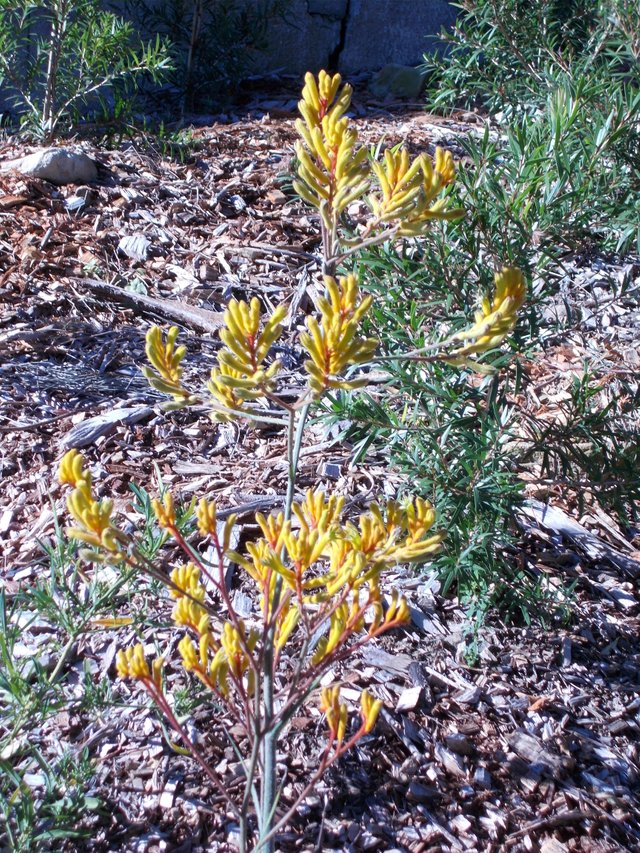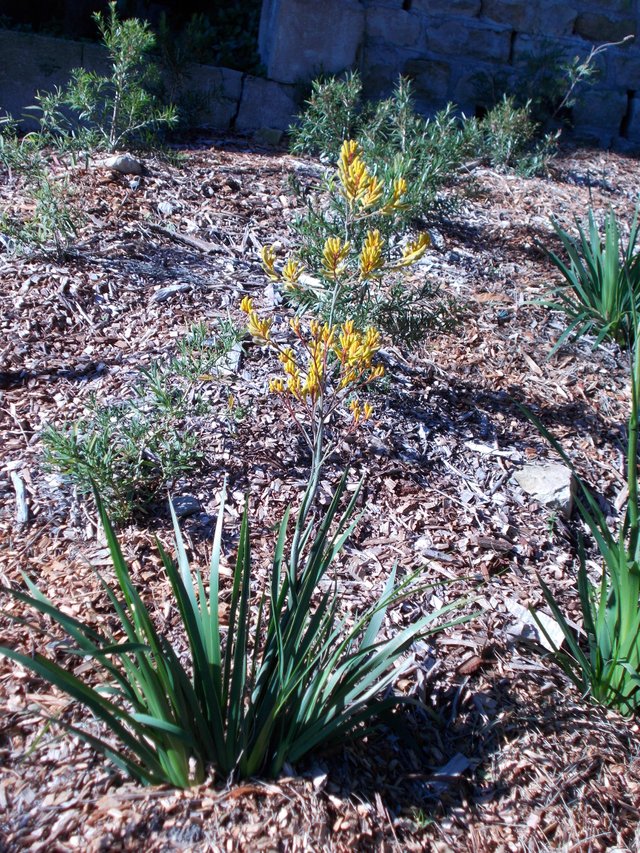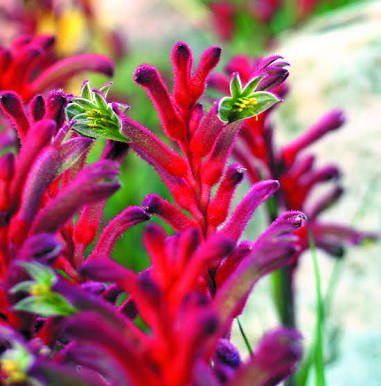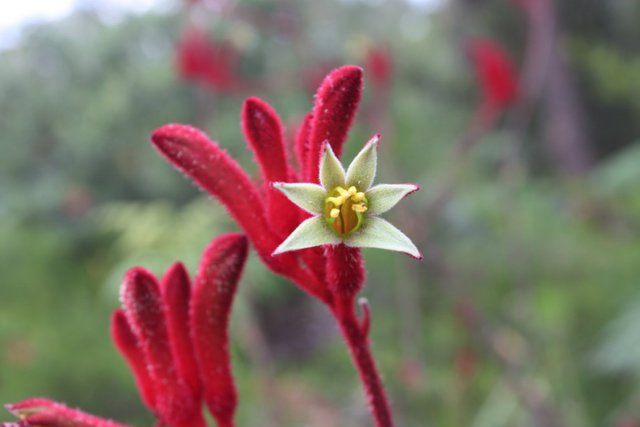Kangaroo Paws - the flowers jump out at you.
Kangaroo Paw is the common name for the Anigozanthus, which is native to Western Australia, It has unique flowers that come in many colours, the flowers emerge from sword-shaped leaves. The plant grows to around 50cm high, and the flower stalks grow up to 1 metre high. Plant your Kangaroo Paws in well drained soil in the full sun. It is suitable for cool-temperate to warm climates. There are many colours available, and some of the modern hybrids are spectacular, one having black and green flowers. Many varieties are Ink spot resistant - ink spot is a disease that turns parts of the leaves black. I photographed this plant in a harbourside reserve.


The kangaroo paw is endemic to the south-west of Western Australia. It is a wonderful demonstration of the beauty of nature. I took particular interest and fascination in the kangaroo paw thanks to its brilliant colours and exciting name.
Their vibrant, almost iridescent flower colours are combined with a beautifully furry texture created by the hairs that cover the stems and flowers—and provide the latter’s colour. Another oddity is the way the colour varies according to temperature, with cooler days producing more intense shades.
The amount of light intensity can also affect the flowers…. plants grown with some shading can have different colour intensity to ones grown in full sunshine. Thus the same species in bloom can look completely different in different environments.
Resouces
Fav. comment Award !! Thanks for the nice Pics !
Thank you @ctrl-alt-now!
@ctrl-alt-nwo,
Definitely it might be an unique plant! That's why I heard that name first time and "Kangaroo Paw" meaning it's from Australia as well! Nice photography and description for the people who wish to plant this flower! Thank you!
Cheers~
This Australian native won't add any edible value to your garden, but it will bring a host of colorful blossoms! Named for the unique shape of its flower, the kangaroo paw is quickly growing in popularity in gardens all around the world.
Although kangaroo paws are now commercially grown, they are originally endemic to drought-prone southwestern Australia and are characterized by their rhizomatous growth. By growing from an underground rhizome (modified root), the plants are able to conserve water and use it to keep the foliage hydrated during times of drought.
These perennial plants can adapt to a variety of climates and conditions. This not only makes them great for no-hassle landscaping projects but also perfect for planting in containers on your porch or patio! Bring some color and excitement to your gardens by learning the basics of caring for kangaroo paws.
https://dengarden.com/gardening/Kangaroo-Paw-Plant-Care
This whimsical plant gets its common name from its woolly, tubular flowers, which open to look like a kangaroo’s curved fingers. Although they’ve become a common site in California gardens, kangaroo paws are native to southwestern Australia. There they grow wild in sunny areas that get winter rain, and can be seen growing along roadsides. They’re pollinated by birds and small nectar-feeding possums. As a bird (or possum) feeds on the nectar deep inside a flower, pollen rubs off the anthers and onto its head. As the bird flits from flower to flower, it distributes pollen onto the stigmas of other flowers while picking up more pollen.
http://animals.sandiegozoo.org/plants/kangaroo-paw
This remarkable group of Australian plants typifies what is unique about many of our native plants. They have vibrant, almost iridescent flower colours combined with an amazing, furry texture provided by the hairs that cover the flowers and stems (and incidentally provide the colour for the blooms).
Kangaroo paws also typify the frustrations of growing many of our native plants in that many varieties can be rather unreliable in cultivation. In spite of all that, kangaroo paws are now well established as garden plants, particularly the many named hybrids that have been released over the last 25 years.
There are some good reasons why some gardeners are unsuccessful with kangaroo paws and a lot of the blame lies with the lack of choice in the market place.
https://gardendrum.com/2015/06/27/how-to-choose-and-grow-kangaroo-paws/
Oh yeah @ctrl-alt-nwo, this iconic Aussie plant is loved for its stunning flowers which attract birds and also make great cut flowers.
In a nutshell kangaroo paws come from regions which experience cool wet winters and warm dry summers. If you can replicate this then your plants will thrive. If your climate is different to this then try the taller varieties as they are more adaptable. Alternatively grow the smaller types in pots and view them as short-lived perennials. With this in mind you can get happily grow them in cool, temperate and subtropical climates around Australia.
As mentioned above kangaroo paws aren’t sensitive to phosphorus (except the black kangaroo paw) so you can use regular fertilisers on them. Fertilise when the plants are actively growing with a slow release organic fertiliser, compost or aged manure. Potted specimens will especially benefit from regular doses of eco-aminogro to support their flower production. Use eco-seaweed as well to encourage thicker cell walls which makes it harder for fungal diseases to take hold.
Snails and slugs may attack fresh growth but the biggest problem comes from fungal diseases. These appear when the growing conditions aren’t ideal or when the plant is losing vigour at the end of its life. Crown and root rots, kangaroo paw rust and ink spot are the major culprits. Remove affected leaves and improve growing conditions (eg more sun, better drainage and air flow). Some commercial growers incorporate eco-fungicide into their spray program as well. In a home garden situation keep plants vigorous and healthy with regular applications of eco-seaweed and eco-aminogro as your first line of defence.
https://ecoorganicgarden.com.au/gardening-tips/how-to-grow-kangaroo-paws/
Kangaroo Paws are truly one of Australia’s most iconic plants; the flower features as the floral emblem of West Australia and has even appeared on a number of stamp issues.
Kangaroo Paws originate from the south west of Western Australia and of the 12 species 11 are from the Anigozanthos genus.
The 12th is particularly distinctive. It comes from the Macropidia genus and is known as the Black Kangaroo Paw because of its black and green flowers.
The vibrant flower colours and unusual paw-like flower head (that gives them their name) have made Kangaroo Paws immensely popular garden plants across Australia and around the world.
.

Source
Kangaroo Paw flowers are highly distinctive with their finger-like projections and the cover of fine velvet hairs that give the flowers their colour.
In the wild the flower colours range from red and green through various shades of reds and yellows to the black and green of the Macropidia fuliginosa.
.
.jpeg)
Source
.
Kangaroo Paws do best in slightly acidic soils with good drainage and full sun exposure. They do not like wet feet but they will cope with a range of soils if there is good structure in the soil. Very high phosphorous levels may also be detrimental to some Kangaroo Paw species.
Most Kangaroo Paws will die back and become dormant over winter. You should take advantage of this characteristic to cut back most of the leaves and old flower stems to ground level (see pruning section).
.

Source